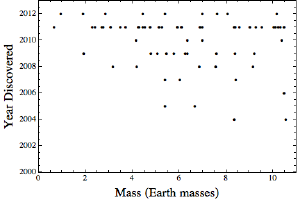Post
New Earths
24 September 2012
The search for planets around other stars has led to the discovery of over 800 extrasolar planets. Most of these are large, Jupiter type planets orbiting close to their star since those planets are easier to detect. Our techniques are getting better, however, and that means not only more planets discovered every year, but also smaller planets.
In the figure below I’ve plotted the masses of discovered planets vs the year of their discovery. I’ve only plotted planets that have around 10 earth masses or less, which are often called “super earths” because they are Earth-like (rocky) planets with a larger mass than Earth.
 Brian Koberlein
Brian KoberleinWhat is interesting about this graph is that the minimum mass planet of each year keeps getting smaller, to the point that we are now discovering planets almost as small as Earth. Within the next year or so we will start discovering planets of Earth mass or smaller, and eventually one of those planets will be in the habitable zone of its star. We will have discovered the first “new Earth.”
Of course even when we discover an Earth mass planet with an Earth-like temperature, that doesn’t guarantee that it will have life. But what it will show is that planets like ours are not alone in the universe. Our pale blue dot will have sisters.
We’ve come a long way since the first extra-solar planet was discovered in 1995. Within a decade of that discovery we will likely identify dozens of earth-like worlds, which is nothing short of amazing.